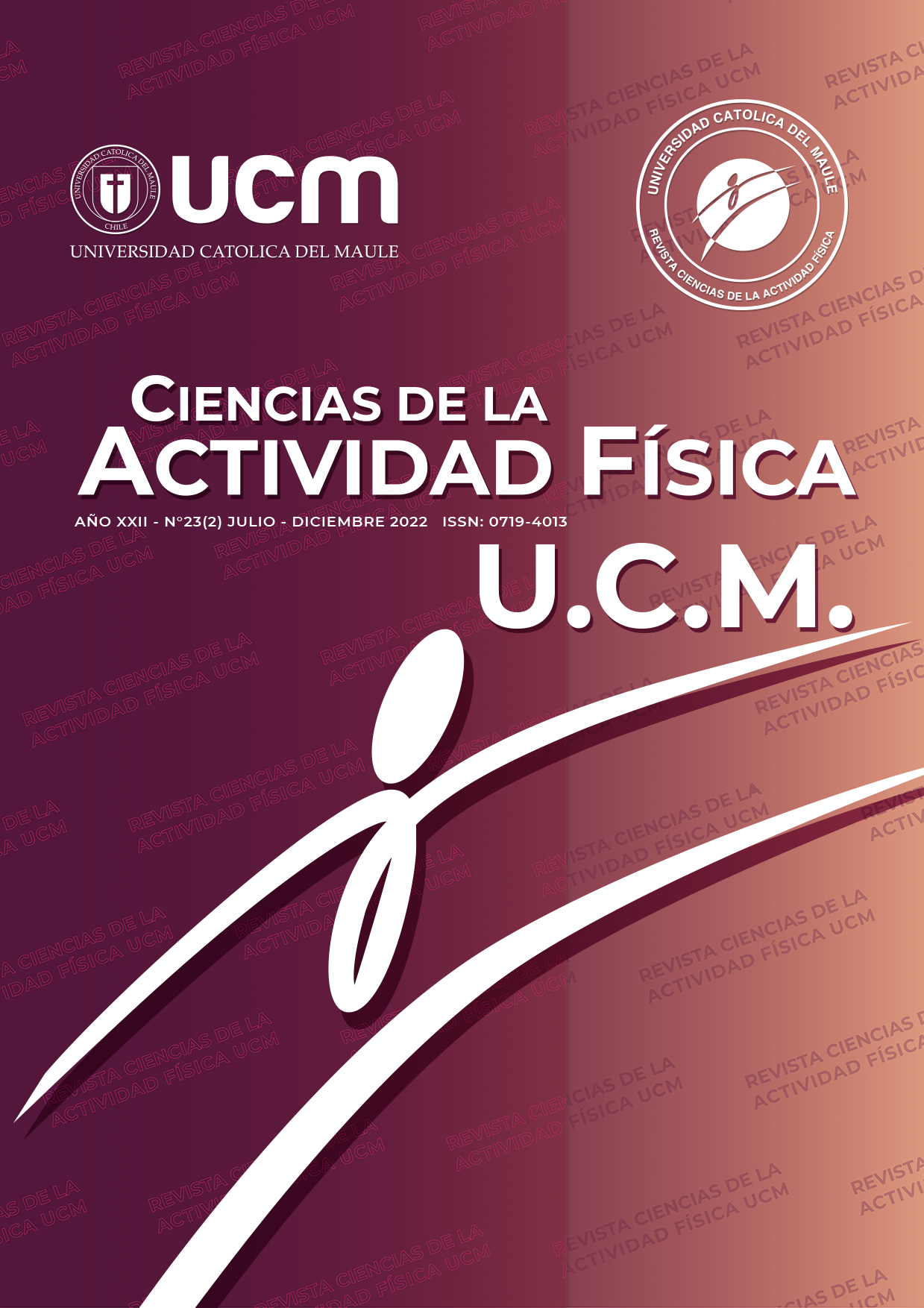Análisis del Rendimiento Físico en Jugadores de Hockey sobre Césped sub 14
Contenido principal del artículo
Resumen
Detalles del artículo
Barbero-Álvarez, J. C., Soto, V. M., & Granda, J. (2005). Diseño, desarrollo y validación de un sistema fotogramétrico para la valoración cinemática de la competición en deportes de equipo. European Journal of Human Movement, (13), 145-160. https://www.redalyc.org/pdf/2742/274220877010.pdf
Barros, R. M. L, Misuta, M. S., Menezes, R. P., Figueroa, P. J., Moura, F. A., Cunha, S. A., Anido, R., & Leite, N. J. (2007). Analysis of the distances covered by first division Brazilian soccer players obtained with an automatic tracking method. Journal of Sports in Science and Medicine, 6(2), 233-242. https://www.ncbi.nlm.nih.gov/pmc/articles/PMC3786245/
Boyle, P. M., Mahoney, C. A., & Wallace, W. F. (1994). The competitive demands of elite male field hockey. The Journal of sports medicine and physical fitness, 34(3), 235–241.
Buchheit, M., Mendez-Villanueva, A., Simpson, B. M., & Bourdon, P. C. (2010). Repeated-sprint sequences during youth soccer matches. International. Journal of Sports Medicine, 31(10), 709-716. https://doi.org/10.1055/s-0030-1261897
Buchheit, M., & Laursen, P. (2019). Science and Application of High-Intensity Interval Training Solutions to the Programming Puzzle. Human Kinetics.
Buglione, A., Ruscello, B., Milia, R., Migliaccio, G. M., Granatelli, G., & D’Ottavio, S. (2013). Physical and physiological demands of elite and sub-elite field hockey players. International Journal of Performance Analysis in Sport, 13(3), 872–884. https://doi.org/10.1080/24748668.2013.11868695
Carling, C., Bloomfield, J., Nelsen, L., & Reilly, T. (2008). The role of motion analysis in elite soccer: contemporary performance measurement techniques and work rate data. Sports Medicine, 38(10), 839-862. https://doi.org/10.2165/00007256-200838100-00004
Canda, A. S. (1996). Estimación antropométrica de la masa muscular en deportistas de alto nivel. Métodos de estudio de composición corporal en deportistas. Consejo Superior de Deporte.
Castellano, J., & Casamichana, D. (2014). Alternativas en la monitorización de las demandas físicas en fútbol: pasado, presente y futuro. Revista Española de Educación Física y Deporte, (404), 41-58. https://www.reefd.es/index.php/reefd/article/view/45
Cussaría, J., Ortega-Gálvez, M. J., Porras-Alvarez, J., & Gálvez-Gonzalez, J. (2019). Demandas físicas y fisiológicas en el Hockey hierba femenino: diferencias entre los tiempos de juego. Retos, 35, 273-277. https://doi.org/10.47197/retos.v0i35.64151
Del Coso, J., Portillo, J., Salinero, J. J., Lara, B., Abian-Vicen, J., & Areces, F. (2016). Caffeinated energy drinks improve high-speed running in elite field hockey players. International Journal of Sport Nutrition and Exercise Metabolism, 26(1), 26–32. https://doi.org/10.1123/ijsnem.2015-0128
Dewar, H., & Clarke, J. (2021). Peak Running Intensities in Field Hockey-a Positional Analysis. Journal of Human Kinetics, 79(1), 135-144. https://doi.org/10.2478/hukin-2021-0067
Doncaster, G., Page, R., White, P., Svenson, R., & Twist, C. (2020). Analysis of Physical Demands During Youth Soccer Match-Play: Considerations of Sampling Method and Epoch Length. Research quarterly for exercise and sport, 91(2), 326–334. https://doi.org/10.1080/02701367.2019.1669766
Gabbett, T. J. (2010). GPS analysis of elite women’s field hockey training and competition. Journal of Strength and Conditioning Research, 24(5), 1321–1324. https://doi.org/10.1519/JSC.0b013e3181ceebbb
Hakkinen, K. (1996). Aplicaciones prácticas del entrenamiento de la fuerza. INFOCOES, 1(2), 49-55.
Hartwig, T., Naughton, G., & Searl, J. (2009). Load, stress, and recovery in adolescent rugby union players during a competitive season. Journal of Sports Sciences, 27(10), 1087-1094. https://doi.org/10.1080/02640410903096611
Hopkins, W. G. (2003). A spreadsheet for analysis of straightforward controlled trials. Sportscience, 7. https://www.sportsci.org/jour/03/wghtrials.htm
Jennings, D., Cormack, S., Coutts, A., & Aughey, R. (2011). GPS Analysis of an International Field Hockey Tournament. International. Journal of sports physiology and performance, 7(3), 224-231. https://doi.org/10.1123/ijspp.7.3.224
Johnston, T., Sproule, J., McMorris, T., & Maile, A. (2004). Time-motion analysis and heart rate response during elite male field hockey: Competition versus training. Journal of Human Movement Studies, 46(3), 189–203. https://www.research.ed.ac.uk/en/publications/time-motion-analysis-and-heart-rate-response-during-elite-male-ho
Liebermann, D. G., Katz, L., Hughes, M. D., Bartlett, R. M., McClements, J., & Franks, I. M. (2002). Advances in the application of information technology to sport performance. Journal of Sports Sciences, 20(10), 755-769. https://doi.org/10.1080/026404102320675611
Lythe, J., & Kilding, A. E. (2011). Physical demands and physiological responses during elite field hockey. International Journal of Sports Medicine, 32(7), 523–528. https://doi.org/10.1055/s-0031-1273710
Moraguez-Iglesias, A., Espinosa-Torres, M. P., & Morales-Peralta, L. (2017). La prueba de hipótesis Kolmogorov-Smirnov para dos muestras grandes con una cola. Revista Luz, 16(3), 80-92. https://luz.uho.edu.cu/index.php/luz/article/view/843
Molina, I., Gómez, N., Hernández, C., & Pavez, G. (2021). Composición corporal, somatotipo, rendimiento en salto vertical y consumo máximo de oxígeno en futbolistas profesionales y universitarios. Revista Ciencias de la Actividad Física UCM, 22 (2), 44-56. http://doi.org/10.29035/rcaf.22.2.4
Polglaze, T., Dawson, B., Buttfield, A., & Peeling, P. (2018). Metabolic power and energy expenditure in an international men's hockey tournament. Journal of Sports Sciences, 36(2), 140-148. https://doi.org/10.1080/02640414.2017.1287933
Reilly, T., & Thomas, V. (1976). A motion analysis of work-rate in different positional roles in professional football match-play. Journal of Human Movement Studies, 2, 87-97.
Rienzi, E., Drust, B., Reilly, T., Carter, J. E. L., & Martin, A. (2000). Investigation of anthropometric and work-rate profiles of elite South American international soccer players. Journal of Sports and Medical Physical Fitness, 40(2), 162-169. https://pubmed.ncbi.nlm.nih.gov/11034438/
Sunderland, C., & Edwards, P. (2017). Activity Profile and Between-Match Variation in Elite Male Field Hockey. Journal of Strength and Conditioning Research, 31(3), 758-764. https://doi.org/10.1519/JSC.0000000000001522

Esta obra está bajo una licencia de Creative Commons Reconocimiento-NoComercial-CompartirIgual 4.0 Internacional

